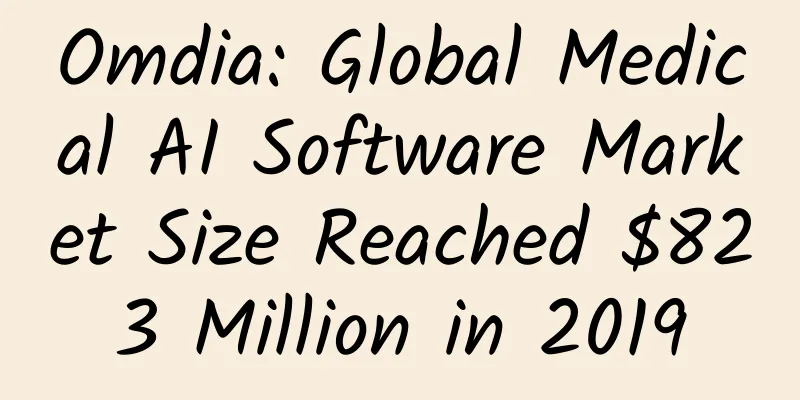Omdia: Global Medical AI Software Market Size Reached $823 Million in 2019

|
Omdia considers the healthcare artificial intelligence ( AI ) market to be nascent because it is relatively small compared to the total addressable market. Omdia estimates that the global healthcare AI software market was worth $ 823 million in 2019 , making it the sixth largest AI industry by revenue, but still a small fraction of the $ 16 billion total AI software market. Omdia predicts that the healthcare AI software market will grow to more than $ 10 billion by 2025. This dramatic growth will be driven by the sheer size of the medical device market, which totaled $ 214 billion in 2019 , and the large investments available to the healthcare industry. Although the healthcare industry offers great potential, the healthcare AI market remains mostly untapped as the technology is still in its early stages of development and faces hurdles such as regulation, with many healthcare organizations unsure of the value of AI. AI vendors have developed advanced AI algorithms that can be applied to medical devices, especially medical imaging devices. Many major medical device manufacturers have partnered with these vendors to incorporate AI tools into their product lines or develop AI software tools internally . Collaboration between healthcare institutions, device manufacturers, and AI vendors will be key to ensuring that healthcare challenges are addressed. AI has the potential to help address the growing problem of strained healthcare services by helping healthcare institutions provide better services to patients with limited resources. The pandemic caused by the 2019 novel coronavirus ( COVID-19 ) has exacerbated these issues, making medical AI extremely important. Medical AI, especially AI for ultrasound, is developed in collaboration with end users to solve real problems According to the Omdia Artificial Intelligence in Ultrasound Survey ( AIUS ) 2020 , many medical practices rely on AI to address the most important areas of improvement, including image quality and standardization, workflow efficiency, and diagnostic support. For example, algorithms assist in prioritizing and screening patients. Secondly, AI guides ultrasound users through scans and enhances images to ensure high-quality and consistent scans that are easy to interpret. Finally, AI can identify anatomy and abnormalities on scans and take measurements to help readers interpret scans. The role of AI is to safeguard and ensure that radiologists do not miss anything of concern in the scan, while also serving as a second opinion to increase radiologists' diagnostic confidence. Figure 1: AIUS survey results ─ The most important AI features Source: Omdia According to AIUS , AI in ultrasound is versatile, with 60% of respondents using AI in multiple clinical applications . Utilization of AI in general imaging is the most commonly reported clinical application, but Omdia expects utilization of AI in planning of care ( POC ), cardiology, and non-traditional applications to increase in the coming years as image libraries grow and the development of more specialized algorithms becomes possible . In addition to the use of portable medical imaging devices, the growth of AI in edge and POC environments will drive the integration and cloud deployment of AI. AI enables more efficient and effective diagnosis, which is critical during the COVID-19 pandemic As the virus continues to wreak havoc on healthcare systems around the world, healthcare organizations are adopting AI as an important tool in the fight against COVID-19 . AI is being used to quickly screen and triage COVID-19 patients and identify symptoms in scans. This can help healthcare organizations limit the spread of the virus and treat more patients quickly. While many healthcare organizations are using pre-existing AI , a number of AI vendors and device manufacturers have developed and continue to develop AI software to help identify and diagnose pulmonary and cardiovascular symptoms associated with COVID-19 . The accelerated development of software, increased funding, and loosening of regulations speak to the benefits and growing understanding of AI for COVID-19 . To popularize medical AI , its value must be conveyed to more audiences While in many cases the advantages of using a new technology are only anecdotal, the benefits of AI are supported by several metrics tracked by healthcare administrators. According to AIUS , 85% of respondents reported that AI saved their practice time, 69% reported that using AI saved their practice money, 82% cited improved diagnosis as the top driver for AI adoption , 74% reported that AI increased their utilization of ultrasound, and 49% reported that AI reduced the amount of training required for technicians to operate ultrasound. These results are significant because they show that the vast majority of respondents saw measurable improvements after using AI . Healthcare organizations that have adopted AI clearly understand its value, as reflected in usage rates. AIUS results show that 73% of respondents use AI capabilities at least once a day, and 40% use them once an hour. This buy-in from the healthcare community is critical to the widespread implementation of medical AI . AI vendors should continue to work with device manufacturers, healthcare organizations, and medical schools to identify key AI applications and promote adoption. |
<<: Facing the integration of three networks, operators should make new cakes
Recommend
Google, BlackBerry team up to make Android devices more secure
BlackBerry has announced a partnership with Googl...
Ejection seat, the skyguard of the skyguard
Some people say that the last line of defense to ...
Can I register again after canceling my Douyin account? How long does it take before I can register again after canceling my TikTok account?
After many friends register a Douyin account, the...
Let me show you some colors! The source of color in the food world
Food pigments are food additives that can be cons...
Musk's long Weibo post sparked controversy 360 car companies jointly empower safe driving
Recently, Musk released a long microblog titled &...
Zhengyi Wireless: Using Internet thinking to build AppCan enterprise mobile platform
Now, everyone and every company has begun to get ...
I will use a 7,000-word article to teach you how to build a popular paid community from scratch
How can ordinary people create a community that c...
An explosion at a firecracker factory in Guanghan, Sichuan, has injured six people
CCTV reporters learned from the scene that the fi...
How can an undersea tunnel built between two places “run in both directions”?
From Ningbo to Zhoushan, a project is under const...
Will the small-screen, low-priced iPhone be a nightmare for low-end Android phones?
Not long ago, rumors about Apple launching a 4-in...
A complete set of fission activity skills!
I was so angry. I saw a teacher talking about fis...
How to follow the hot topics of Qixi Festival with new media operators?
Chinese Valentine's Day is here again~ Some p...
The 2016 death list of e-commerce and physical stores!
During this year’s Double 11, Uniqlo’s Tmall flag...
Can't drink coffee during recovery from COVID-19? Here comes the January scientific rumor list!
1. Do not drink coffee during the recovery period...
15 Most Commonly Used Online Channels for Event Promotion (Recommended Collection)
When an operator plans a complete activity plan, ...







![[Li Jiaoshou] How to conduct consumer research without a large budget?](/upload/images/67cc39c0bf80e.webp)

